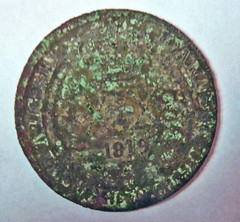
PREV ARTICLE
NEXT ARTICLE
FULL ISSUE
PREV FULL ISSUE
CAPE COD METAL DETECTORISTSThis article from a local Cape Cod paper describes local metal detectorists and their finds. below is an image of an 1819 Brazilian coin. -Editor
Sometimes, the thrill of discovery even prompts these adventurers to carry their bulky metal-detection equipment to foreign lands in search of artifacts from long-forgotten eras. A mix of informed guesswork and a healthy dose of imagination makes it possible for detectors to conjure from their finds some interesting tales from our region’s history. The finds can be as ancient as Roman-era spearheads and silver coins dug up in Spain or as contemporary as a wedding ring lost last summer at the local beach. A few items turn out to be valuable, as with a 5-dollar U.S. gold coin minted in 1834. More often they are everyday items like colonial-era and early U.S. coins, or perhaps Civil War relics dug up at battle sites and cemeteries. The most mysterious recent find in Yarmouth is a 198-year-old Brazilian copper coin dug up from the ground at Bangs Hallet House. The 20-Reis coin was found by Ken Camilleis, veteran detector and Historical Society of Old Yarmouth member. Camilleis, the “dirt-digger” who discovered the 20-Ries coin at Bangs Hallet House, notes that it was minted in 1819 in Brazil when it was still part of Portugal’s global empire. Displayed on one side are the Portuguese Crown and XX to show its value (Reis is plural of Real, translating as Royal). The coin’s other side portrays a globe, latitude lines and a coat of arms, with the Latin words Circumit Orbe (Circling the Globe) and Pecunia (Money) scrolled around the edge. Today, this well-worn piece sells online for as little as $3. How did this coin end up at the historic Yarmouth Port home at 11 Strawberry Road and near the commons off Route 6A? One possibility is that sometime after 1819 it was lost by one of the many customers of a general store run by the Thatcher family between 1802 and 1832 and using the original building at this site. Alternatively, the coin could have belonged to a resident at the site after 1850, when an expansion of the pre-existing structure created the Bangs Hallet House as it appears today. Good candidates would be two sea captains who occupied the residence after its rebuilding, and who may have acquired the coin while voyaging to far-off lands. See a related article later in this issue about London's mudlarks. -Editor
To read the complete article, see:
 Wayne Homren, Editor The Numismatic Bibliomania Society is a non-profit organization promoting numismatic literature. See our web site at coinbooks.org. To submit items for publication in The E-Sylum, write to the Editor at this address: whomren@gmail.com To subscribe go to: https://my.binhost.com/lists/listinfo/esylum All Rights Reserved. NBS Home Page Contact the NBS webmaster 
|
